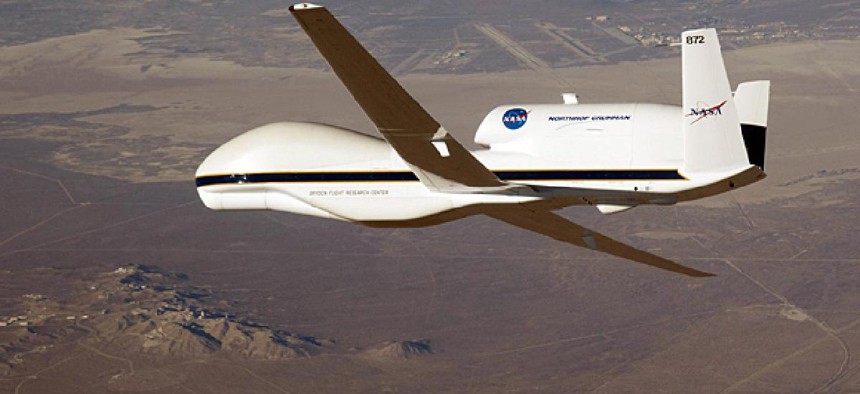New tool for hurricane trackers: drones

Weather researchers hope drones like NASA's Global Hawks can take hurricane tracking to a new level. NASA
NASA and NOAA researchers hope pair of military-surplus Global Hawks provide new insight into storms.
Federal hurricane trackers this year will be experimenting with powerful new tools: unmanned boats and aircraft, including a massive drone more known for spying on battlefields than monitoring nature’s violence.
Researchers at NASA and the National Oceanic and Atmospheric Administration are hoping a pair of military-surplus Global Hawk spy drones can provide new insight into the storms that routinely ravage the Atlantic and Gulf coasts.
The aircraft, also known as unmanned aerial vehicles, or UAVs, won’t be keeping an eye on Hurricane Isaac, which barreled down on the Gulf Coast on Tuesday. That storm is being monitored by more traditional means, including manned “Hurricane Hunter” aircraft, but officials expect to have the drones up and running in time for the height of hurricane season.
Next week, the first of two Global Hawk aircraft is scheduled to arrive at NASA's Wallops Flight Facility in Virginia, with a shakedown flight scheduled to happen soon after. The second aircraft is expected to arrive in coming weeks with officials hoping for a first flight in mid-September.
The aircraft, built by Northrop Grumman, were among the first batch to be tested by the military. When the military sought upgraded aircraft, the drones ended up in the hands of NASA researchers, who, along with their counterparts at NOAA, have now fitted them with specialized sensors for monitoring storms.
Weather researchers have used or experimented with various unmanned vehicles for years (not to mention the original unmanned vehicles: weather satellites). But officials are now taking the technology to new levels.
NASA's Global Hawks, for example, were first used to gather data during a limited number of flights in 2010, but researchers are hoping that updated technology and new base closer to Atlantic hurricanes will make the experiments better than ever, said Scott Braun, a NASA investigator who leads the Global Hawk experiments.
The three-year program is just starting, and for now NASA’s plan is focused on basic research, rather than real-time forecasting. Still, with a 116-foot wingspan and an ability to stay in the air for nearly 30 hours, the Global Hawk promises to be extremely useful for observing hurricanes.
But don’t look for drones to replace the famous manned “Hurricane Hunter” aircraft that fly directly into the middle of hurricanes anytime soon.
Researchers have small UAVs that can survive the forces inside a hurricane, but they are too small to carry a wide range of sensors, Braun said. Larger aircraft like the Global Hawk, meanwhile, can’t handle such extreme weather. While manned flights into hurricanes can seem dangerous, only four such aircraft have been lost since 1943, the last one in 1974.
“We are still a long ways away from replacing manned flights,” he said. Instead, the UAVs will supplement manned flights by flying at altitudes of up to 60,000 feet, thousands of feet above the thrashing winds and rain. One aircraft is designed to gather data about the environment around a storm, while the other UAV will study the storm itself.
It’s not the first time NASA has turned to spy aircraft for weather research. Since the 1970s, the space agency has used a version of the military’s U-2 aircraft to conduct a range of observations on everything from wildfires to migratory birds, as well as hurricanes. (During the 1960s, NASA unsuccessfully tried to help cover up Francis Gary Powers’s failed U-2 spy mission in the Soviet Union by claiming he got lost while conducting weather research.)
Like the military, NASA and NOAA are now looking to unmanned vehicles to either replace or bolster more traditional vehicles.
While Global Hawks may soon be a regular fixture above hurricanes, NOAA is experimenting with small, unmanned watercraft to penetrate storms at sea level.
The Wave Glider is a solar- and wave-powered floating platform that can take measurements from both the air and sea. Wave Gliders have been used for a range of weather and climate research, but now NOAA is experimenting with placing the craft in the path of oncoming hurricanes.
Unlike other craft, in theory, the Wave Glider can stay out indefinitely thanks to its solar panels and energy gathered from waves, said NOAA’s Alan Leonardi. “The idea is to position a string of these in the path of a hurricane and gather data in a way we haven’t been able to before,” he said.
Also in the expanding NOAA arsenal of unmanned research vehicles is EMILY, a 65-inch watertight unmanned surface vehicle outfitted with a range of sensors and a high-definition camera. This year, scientists hope to remotely guide the craft into the center of hurricanes to gather data in some of the most dangerous areas of the storms.
"With unmanned craft, we’re not risking anybody’s life," said Justyna Nicinska, program manager for NOAA’s EMILY, which was originally developed to help lifeguards with tricky sea rescues. Like other officials, Nicinska expects EMILY to compliment, rather than replace current systems. "EMILY will really fill gaps in our observation," she said.
NEXT STORY: GOP platform blasts Obama on tech policy


